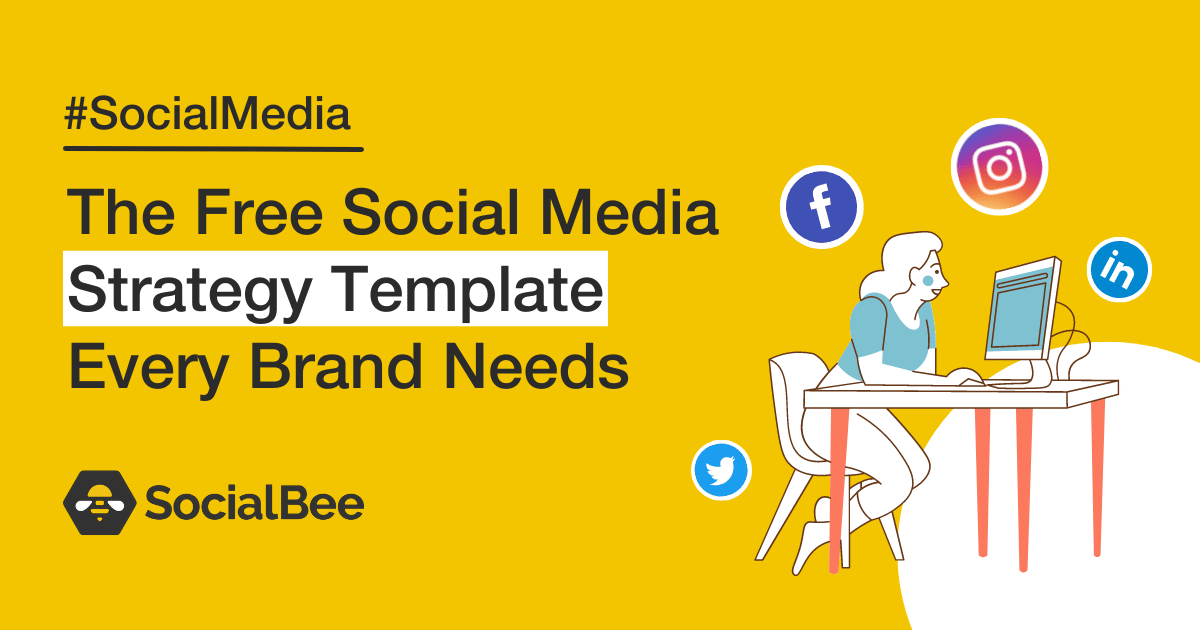
Ron Stefanski
ENTREPRENEUR | OneHourProfessor.com
Memes are funny, engaging, and easy to consume. It’s no wonder they’ve exploded in popularity to become one of the main elements in modern viral marketing on social media.
Brands everywhere are using memes to gain traction in their social media marketing campaigns.
Consider these statistics:
- At least 60% of people use social media for content that’s funny.
- Using social media memes can result in 10 times more reach than images alone.
- In this specific case, memes resulted in 60% organic engagement.
With stats like these, it’s easy to see why meme marketing is growing. But, can you use them as a marketing tool?
The answer is yes, you absolutely can – as long as it’s something that your audience resonates with.
You can incorporate them as a way to humanize your brand and make your content more humorous, compelling, and relatable to your target audience.
Read the rest of this article to discover more about how you can join in this trend of meme marketing and customize your strategy to increase conversions for your brand.
But first, the basics…
What Are Memes?
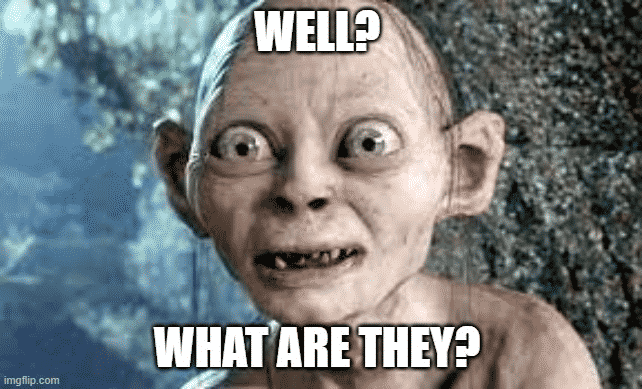
A meme is simply a unit of cultural information – an idea, style, or behavior – that is spread by imitation from one person to another. It can be in the form of an image, video, or a piece of text that is copied (sometimes with slight variations) and virally transmitted across the internet.
Social media memes are often images embellished with text, typically sharing pointed commentary on social ideas, current events, cultural symbols, and more.
Meme marketing is a subset of viral marketing. It’s a digital trend that is growing in popularity and has proven to be an effective way of engaging and converting audiences on social media and other platforms.
How Are Memes Used on Social Media?
Using memes on social media is a great way for companies to showcase their products and services to audiences who don’t like to see ads. That’s what meme marketing is all about.
It gives you the opportunity to engage with your target audience in the simplest way possible.
Looking at the current trends, it’s clear to see that social media memes have evolved to become one of the most effective modes of communication and advertising.
They offer tons of benefits, some of which we’ll look at below.
Benefits of Social Media Meme Marketing
There are many advantages to using memes as part of your social media marketing strategy.
- Memes Are Simple: They are easy to understand and provide brands with a very simple (and inexpensive) way to communicate with, and engage, their target audiences.
- Memes Produce Instant Response: Memes (the good ones, at least) produce instant engagement from your audience since they are relatable to most people.
- They Have Viral Elements: Memes have set a benchmark for viral marketing campaigns. They are a powerful mode of advertising that is designed to be shared, increasing the likelihood of reaching a broader audience.
- They Help You Develop a Sense of Community: Memes help to foster community building when members of online groups share the content with other like-minded people who relate to it.
- They Help You Improve Your Returns: Memes come with a natural kind of wit that allows brands to generate a better return on investment on their content creation.
Major Elements of a Meme
For the most part, when people share your social media memes with colleagues and friends, they engage emotionally with your content and brand. Some of the responses may include humor, sarcasm, fun, friendliness, or a quick laugh.
There are two ways to get started with meme marketing. You can either create your own memes or reuse popular memes that are already out there. Both methods have their own benefits and drawbacks.
Coming up with Original Meme Ideas
Creating your own original memes allows you to set an example and establish yourself as a leader in your space.
Also, there’s almost 0% possibility of copyright issues when creating your own memes. However, this can be difficult to do since you have to come up with your own concept from scratch and there is no way to know if it will become popular. You also have to align the meme’s concept with your brand style and other elements you’ve built as part of your marketing until now.
Using Popular Memes
“Meme-jacking” (hijacking popular memes from other brands) allows you to ride the wave of popular memes so you can use them to positively influence your audience.
These types of memes are easy to create since you already have the concept and they have already been proven successful for social platforms. This means that they’ll work great for attracting engagement and traffic.
Here is a great meme example from Ikea who used the Bernie Sanders meme to promote their products:
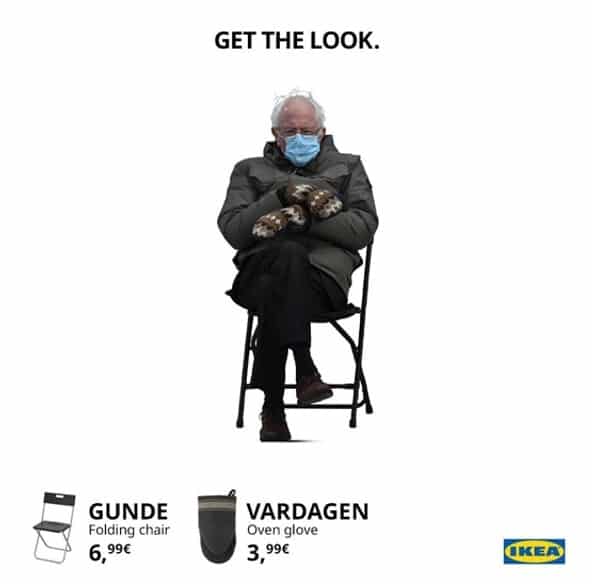
When using popular social media memes, there isn’t much to do except use tools like Canva or Imgflip to search for the most popular meme templates which you can then customize to suit your needs.
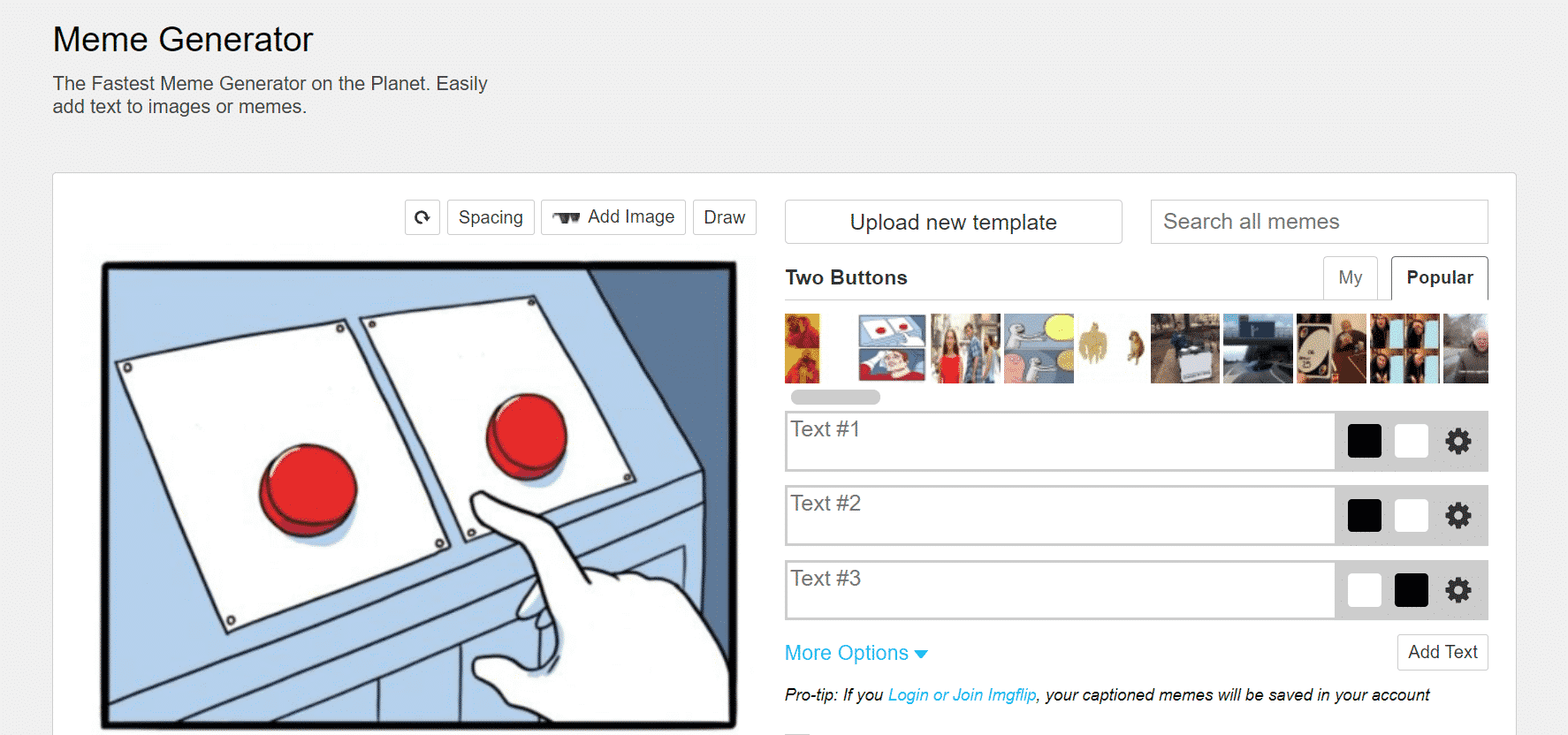
However, if you are creating your own, below are some best practices to help you come up with creative and appealing memes from scratch.
How to Assemble a Meme for Your Brand’s Target Audience
The steps to creating memorable memes that your audience will relate to are as follows:
Step 1: Research Properly
This is the most important step if you want to make the most of your memes. Study your audience deeply and get to know what they like so you can create content that they’ll be happy to share within their networks.
For instance, Tesla’s marketing finds the right balance between engagement and promotion of their fuel-efficient electric cars by using memes with real-life situations that most adult car owners can relate to.
Step 2: Be Consistent with Your Brand Voice
If you are going to create a meme to promote your business, make sure it supports your brand, instead of contradicting it.
For instance, the classic “distracted boyfriend” meme has been used by a variety of brands, but it only works if the highly recognized meme is aligned with the brand voice, as in the meme example below from Ruffles:
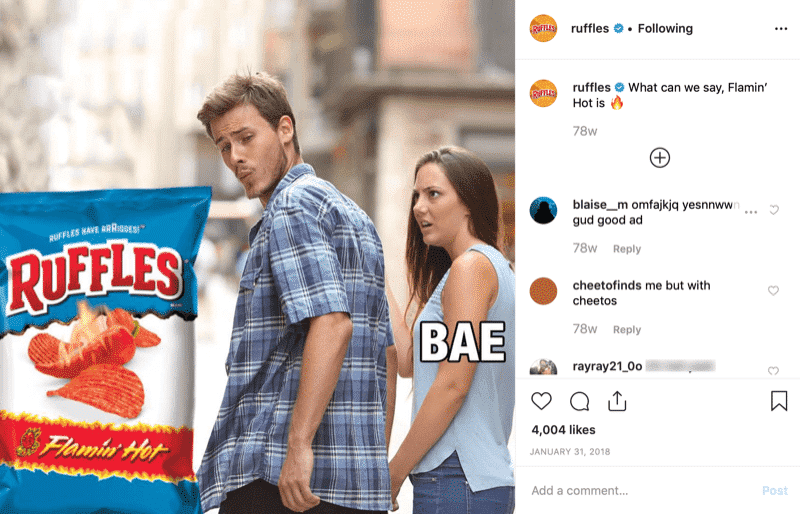
Step 3: Keep Up with Trending Topics
When using memes in your marketing, timelessness is an essential factor, so use tools such as BuzzSumo, Google Trends, Google Alerts to keep up with what’s trending online.
Keep an eye on Facebook and Twitter trends to discover what the people in your audience are talking about.
Remember, memes have a short lifespan, so yours will be a lot more likely to go viral if you can create them based on the popular trend at that time and relate it to common issues.
Get the Latest Social Media Updates!
Step 4: Add Originality to Your Meme
This is perhaps the most important element when assembling engaging memes for your audience.
You can use humor, sarcasm, or other emotions to make your meme interesting. But, don’t forget the main goal of your meme is marketing. You want to use it to increase awareness for your brand, which means you must stand out. The best way to do this is to get creative and add originality to your memes instead of simply reposting the latest ones.
For instance, you might use wit in the caption as a way to attract more engagement and shares from your audience.
Step 5: Create Captions with Hashtags and Contextual Elements
Memes are a great way to grab a user’s attention on social media, but without a captivating caption, you’re not utilizing meme marketing effectively. A caption should include several important elements.
First, add at least 2 relevant hashtags to your brand. For example, the brand name makes a good first hashtag while a second might include a short but catchy slogan that will stick in the user’s mind.
Additionally, the caption should tell the user something more about your brand, product, service, or whatever it is your marketing. You can also include links to information where they can learn more including blog articles, landing pages on your site, eCommerce portal, PLR courses, and more.
Directing users to a short video on your site is a great way to help solidify your brand in their minds and move them one step closer to conversion. There are even free video editors out there that can help you make professional products without breaking the bank.
Meme Marketing Examples
Here are a few meme examples of brands that have increased brand exposure by using memes on social media.
Chipotle
Chipotle is well known for being creative with its social media marketing campaigns. This one is no different and outlines the brand’s creativity. Instead of relying on outside images, they simply used their own product and added a few emojis, as well as some awesome text that sends a clear message to the audience:
Chipotle has something for everyone, which means you can still have it even when you run out of money.
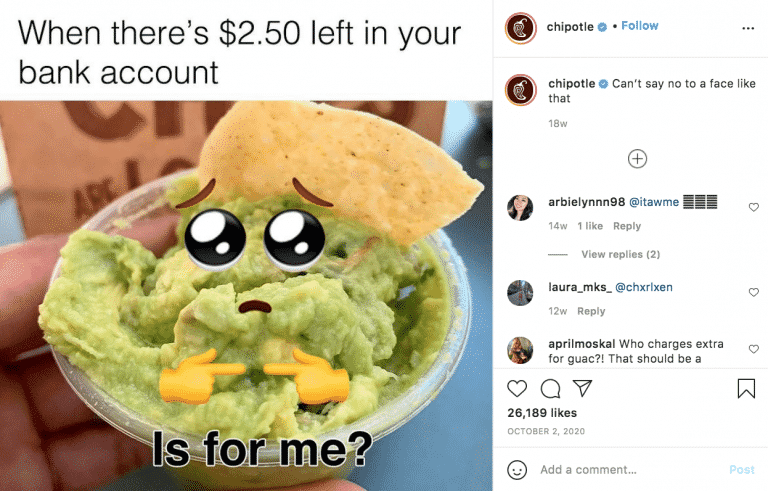
Netflix
Netflix is yet another brand that’s killing it with a strong meme game on social media.
The company has understood for a long time now that humor in advertising is one of the keys to success, and this is evidenced by their memes on social media.
Even dated ones, like the one below, are still relevant years later thanks to the brand’s creativity and originality.
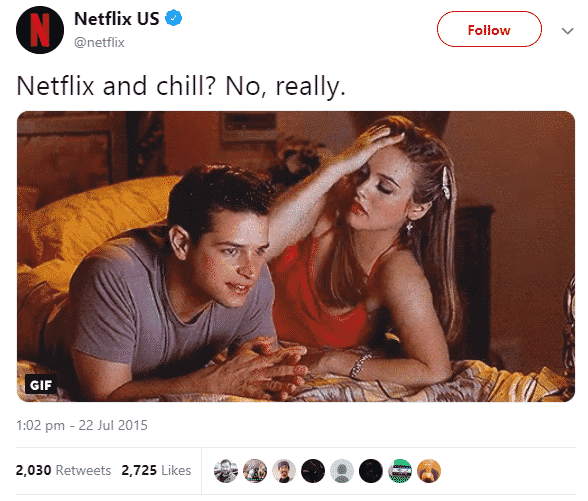
Gucci
Gucci, a luxury fashion brand, used a series of relatable memes created in conjunction with artists from across the globe as part of a campaign designed to promote a new line of ‘Le Marché Des Merveilles’ watches.
Some of the brand’s memes were hilarious and others were downright absurd, but there is no denying that they got great results for the brand.
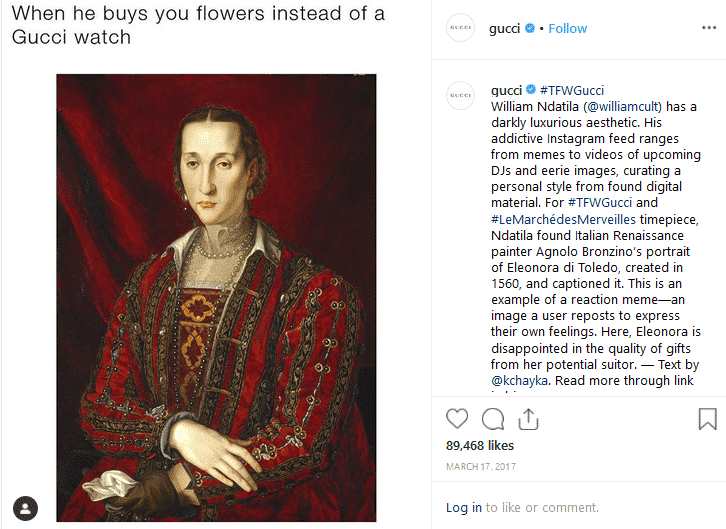
What Content to Include in Meme Captions
Meme marketing has a very low barrier to entry. But, this doesn’t mean that every brand that uses memes will be successful.
In a lot of cases, meme marketing campaigns flop and make the brand look out of touch with its audience. One of the main reasons for this is including content in the caption that isn’t relevant to the audience. So, instead of smashing the “share” or “retweet” button, most users are left scratching their heads.
To help you avoid this, here are a few quick tips for the type of content to include in the captions of your memes.
- Understand the context: If you post without understanding the context, it’s unlikely that you’ll create funny or original content. In fact, your brand may even end up facing embarrassment after posting an awkward meme.
- Don’t change the core message: Sometimes, in an effort to stand out, some brands change popular theme formats to a point where it’s virtually impossible for the audience to get the joke which ultimately leads to confusion and misunderstanding.
- Don’t pick an insensitive topic: Brands must be careful about the topics they joke about. Their actions are unnoticed by their target market, as well as their competitors, which means one wrong move could result in the loss of a profitable audience.
If you fall prey to any of the pitfalls outlined above, your audience will have a hard time understanding your message which will result in low engagement.
How Often Should You Share Memes?
A huge question that marketers often ask is how often to share memes in relation to non-meme content.
The answer is: it depends.
Different marketers have different content marketing objectives. You can test what works best for you and your audience. However, the important thing is to avoid overusing memes.
They are only effective when used sparingly, at the right time, and bombarding your social media audience with memes all the time will take away the fun factor and diminish your influence over them.
Where Else Can I Use Meme Marketing?
Memes are usually shared on social media, but they can be used to enhance other parts of your digital marketing strategy.
For example, you can integrate meme marketing into your email marketing and give your subscribers something new, exciting, and hopefully humorous. Even better, memes can be easily integrated with the best email marketing services on the market.
Additionally, your employees also deserve funny memes. If you’re hosting a webinar, make sure to have a few good memes ready to share. As long as your webinar software allows you to share your screen or upload photos, you’ll be able to treat your employees to the dankest memes.
Conclusion
Memes are being used by more and more brands across the globe. With the right strategy for social media meme marketing, you’ll increase brand exposure and get more conversions from your efforts.
Just remember, it doesn’t end with creating a meme and posting it on social media. You also need to check reactions and engagement levels so you can better understand what your audience likes and continually improve on your content.
Ron Stefanski is a professor and entrepreneur who has a passion for helping people create and market their own online businesses. You can learn more from him by visiting OneHourProfessor.com
You can also connect with him on YouTube and Linkedin.
Post on Social Media with SocialBee!


